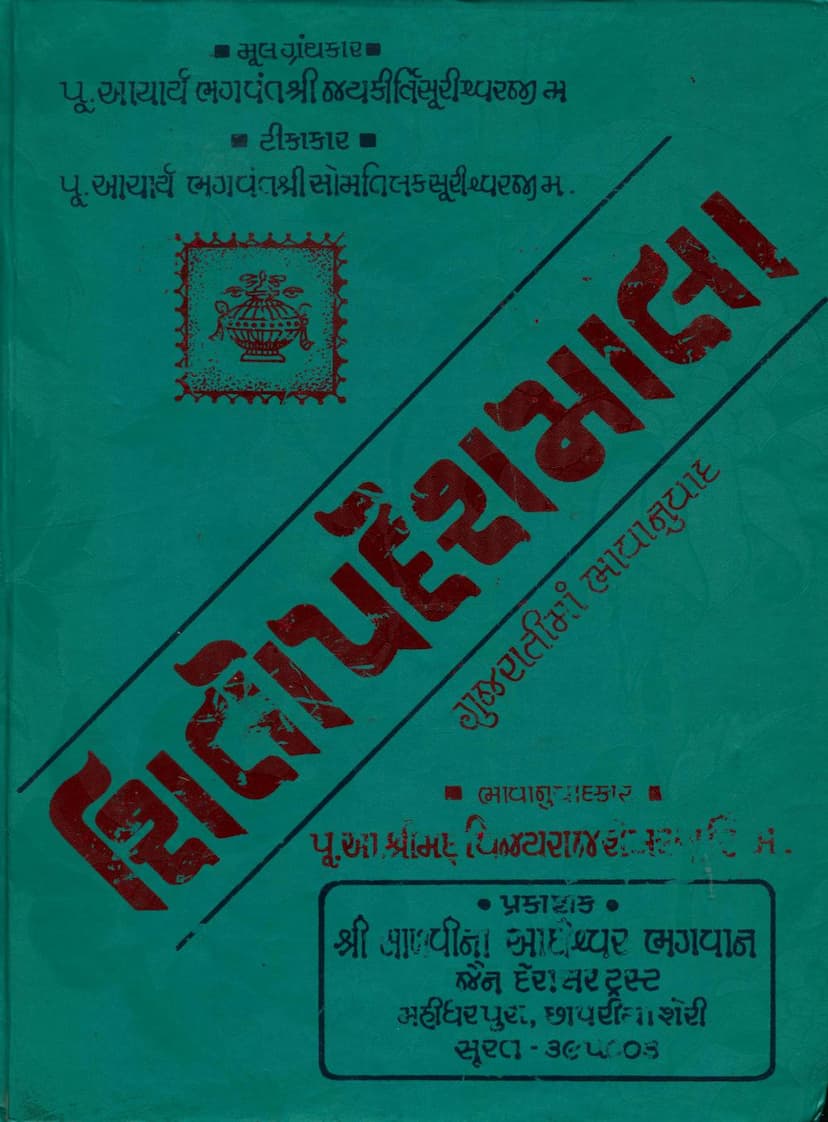Shilopadeshmala
Added to library: September 2, 2025

Summary
This Jain text, titled "Shilopadeshmala" (શીલોપદેશમાલા), is a compilation of teachings and moral guidance, primarily focusing on the concept of "Shil" (શીલ), which in Jainism refers to chastity and righteous conduct. The book is a Gujarati translation and commentary on a work originally authored by Acharya Jaykirtisuri. The commentary is attributed to Acharya Somtilaksuri, and the Gujarati translation (Bhawanuvad) is by Acharya Rajshekharsuri.
Here's a breakdown of the key information presented in the provided pages:
1. Title and Authorship:
- Title: Shilopadeshmala (શીલોપદેશમાલા)
- Original Author: Acharya Jaykirtisuri (મૂળગ્રંથકાર : સકલસિદ્ધાંતસારવેદી પ. પૂ. આચાર્યદેવ શ્રી જયકીર્તિસૂરીશ્વરજી મહારાજ)
- Commentator (on Sanskrit commentary 'Shiltarangini'): Acharya Somtilaksuri (ટીકાકાર : શીતપ્રિય પ. પૂ. આચાર્યદેવ શ્રી સંમતિલકસૂરિ મહારાજા)
- Gujarati Translator/Commentator: Acharya Rajshekharsuri (ભાવાનુવાદકાર : સિદ્ધાંતમહેદધિ સ્વ. પ. પૂ. આચાર્યદેવ શ્રીમદ્વિજય પ્રેમસૂરીશ્વરજી મ.ના પટ્ટાલંકાર પરમગાતાર્થ પરમ પૂજ્ય આચાર્યદેવ શ્રીમદ્વિજય હીરસૂરીશ્વરજી મ. ના શિષ્યરત્ન પરાથપરાયણ પૂજ્ય આચાર્યદેવ શ્રીમદ્વિજયલલિતશેખરસૂરિ મ. ને વિનેય આચાર્યદેવ શ્રી રાજશેખરસૂરિ મહારાજ)
2. Publisher:
- Shree Salvi Na Adishwar Bhagwan Jain Devasar Trust (શ્રી સાળવીના આદીશ્વર ભગવાન જૈન દહેરાસર ટ્રસ્ટ)
- Located in Chapariya Sheri, Surat (છાપરીયા શેરી–સૂરત)
3. Core Message and Content: The "Shilopadeshmala" is presented as a guide on the importance and practice of "Shil" (chastity and moral conduct). The preface highlights:
- The glory of 'Shil': It states that "Shil" means Brahmacharya (celibacy) and the book is a garland of teachings on it.
- Benefits of 'Shil' and harms of breaking it: The text extols the virtues of observing 'Shil' and the detriments of violating it, using numerous examples and engaging narratives.
- Relevance in contemporary society: The publication aims to address the decline in moral values and the rise in instances of transgression, particularly concerning the preservation of chastity, which is seen as a threat to purity.
- Historical significance: The preface mentions that the book was very popular in the past, citing an example of Jindas Shravak who took a vow of celibacy for life after hearing its discourse at a young age.
- Original Language: The original text is in Maharashtri Prakrit, with a Sanskrit commentary named "Shiltarangini."
4. Key Figures Mentioned:
- Acharya Jaykirtisuri: Original author, with limited biographical information available.
- Acharya Somtilaksuri: Commentator on the Sanskrit commentary, also known as Vidyatilak. He authored other works like Virakalpa, Shadgansutra, Laghustav, and Kumarpaldev Charit.
- Acharya Premsooriswarji Maharaj (late): Mentioned as the Guru of Acharya Hirsuriswarji Maharaj.
- Acharya Hirsuriswarji Maharaj (late): Mentioned as the Guru of Acharya Lalitshekharsuri Maharaj.
- Acharya Lalitshekharsuri: Guru of the Gujarati translator, Acharya Rajshekharsuri.
- Acharya Rajshekharsuri: The translator and commentator, whose other works are also listed and praised for their simplicity and inspirational content.
- Shrimati Lalitaben Lallubhai Zaveri: The Poshadhshala where Acharya Lalitshekharsuri stayed during Chaturmas, and from whose knowledge funds this book was published.
- Shrimad Vijay Mahodyasuriji Maharaj: Mentioned as the inspiration for the publication.
5. Publication Details:
- Price: Rs. 40.00
- Year of Publication: Vir Samvat 2519 / Vikram Samvat 2049 / 1993 AD
- Printing: Bharat Printary, Ahmedabad.
- Distribution Point: Shrimati Lalitaben Lallubhai Zaveri Poshadhshala, Madhidharpura, Surat.
6. Content Outline (from the Table of Contents): The table of contents reveals a comprehensive exploration of 'Shil' through various lenses:
- The exalted position of women due to 'Shil'.
- The superiority of householders who practice 'Shil'.
- 'Shil' as the primary cause of Moksha (liberation).
- The praise of virtuous women.
- Examples of great virtuous women (Mahasatis).
- The difficulty of observing 'Shil'.
- The benefits of 'Shil' in this life and the next.
- The shame and downfall associated with the breach of 'Shil'.
- The importance of upholding 'Shil' and the consequences of failing to do so.
- The text includes numerous stories and examples to illustrate its points, covering figures from Jain tradition and general lore.
7. Mangalacharan (Invocation): The text begins with invocations to Lord Adinath, Lord Shantinath, Lord Neminath, Lord Parshvanath, and Lord Mahavir, followed by salutations to the spiritual lineage and a prayer for the well-being of the reader.
8. First Verse and Commentary: The first verse, "Abalambramhacharyam, Nemikumaram namittu jayasaram | Silopadeshamalam, vuchhami viveyakarisalam ||" (આબાલબ્રહ્મચર્યં, નેમિકુમારં નમિત્તુ જયસારં । શીલોપદેશમાલાં, વુચ્છામિ વિવેયકરિસાલાં ॥૧॥), is explained in detail. It highlights Lord Neminath's lifelong celibacy and his role as a guide. The commentary elaborates on the meaning of "Shilopadeshmala" as a "garland of teachings on chastity" and a "hall of the elephant of wisdom."
9. Emphasis on 'Shil': The text repeatedly emphasizes the paramount importance of 'Shil' as a path to liberation, happiness, and virtue. It uses illustrative stories to show the immense power of 'Shil' and the severe consequences of its violation.
In essence, "Shilopadeshmala" is a profound Jain scripture dedicated to promoting and explaining the virtues of chastity and righteous living, emphasizing its crucial role in achieving spiritual liberation and a fulfilling life. The Gujarati translation makes these teachings accessible to a wider audience.